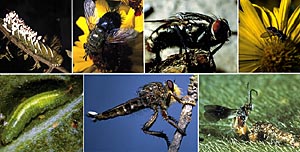

The High Country Xeriscape Council of Arizona is a non-profit 501 C-3 corporation dedicated to educating our communities about water-wise gardening. For additional information write:
HCXCA
4397 E AZ Highway 260
Payson, AZ 85541
By David Salman for High Country Gardens Newsletter (http://www.highcountrygardens.com/)
Beneficial insects ("beneficials") are those that pollinate as well as prey on harmful insects. Attracting beneficials to your property makes good sense; organic farmers have long seen the wisdom of this and make the effort to provide "beneficials" with year-round habitat. This includes food (pollen, nectar and prey) as well as over-wintering sites with various trees and shrubs. You can do the same if you:
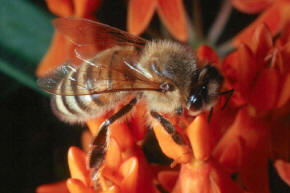
Plant a diversity of plants that attract, feed and shelter beneficial insects.
Leave plants standing over the winter months to provide shelter for eggs, larvae and adults.
Introduce beneficial insects to combat injurious pests and establish (or boost) resident populations of "good bugs."
A good example 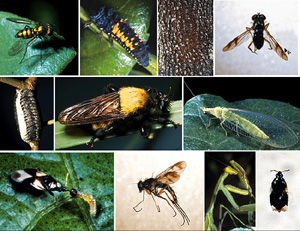
I recently attended a field day for berry and orchard production at a New Mexico State Experimental Station. Some of the day's most interesting information concerned the station's pest control program in its apple orchard. They converted from pesticide- intensive methods of insect control, which is indiscriminate spraying, to techniques that use organic pesticides and pheromones (a hormone chemical substance secreted by insects).
Not only have they improved control of the coddling moth (the nemesis of apple growers), but they've greatly diminished problems with spider mites, aphids and other minor insect pests also. The reason for this change? They no longer spray with broad spectrum insecticides. Therefore the populations of beneficial insects have rebounded, providing the orchard with natural control. 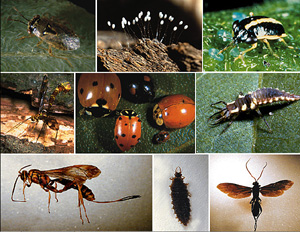
Selective Spraying
Using this model for our own gardens, the first rule of thumb is putting away the non- organic chemical pesticides if we want to attract the beneficials. By spot spraying only where injurious insects have been located and using only organic pesticides you protect the beneficial insects (species that feed on injurious species) while maintaining ecological balance in your yard and garden.
Plants and Insects That Go Together
The lacewings are an excellent predatory insect that feeds on aphids, spider mites, leafhoppers, thrips and whitefly.
 Lacewings can be attracted by planting Ceanothus (wild lilac) and Prunus (cherry and plum) species.
Lacewings can be attracted by planting Ceanothus (wild lilac) and Prunus (cherry and plum) species. Lady Bugs, which help to control aphids, leafhoppers, scales, spider mites and mealybugs can be induced to take up residence by planting Achillea sp. (Yarrow), Asclepias tuberosa Colorado Orange Butterfly Weed, Salix sp. (willow), Ceonothus and Atriplex (Saltbrush) and native grasses.
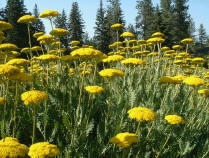
Other beneficial species are attracted by Eriogonum umbellatum 'Shasta Sulfur' (Buckwheat), various vegetables and herbs like carrots, dill, thyme, basil, annual flowers like zinnia and sunflowers and perennial asters.
If you are fortunate to live in proximity to native meadows, you will have a wealth of the "good bugs" as neighbors. In general, unmowed fields, roadsides and hedgerows support healthy populations of beneficials. Value these wild areas and encourage native plant diversity. Don't damage them by constant mowing or spraying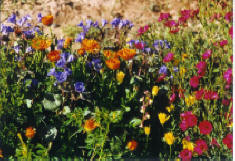 indiscriminately with herbicides and insecticides.
indiscriminately with herbicides and insecticides.
Contact your local state agricultural extension service to obtain information on attracting beneficial insects. This aspect of organic gardening is also receiving a lot more attention from state universities and they can further provide more specific information.
copyright 2003-2009© HCXCA
